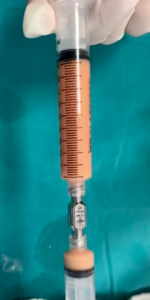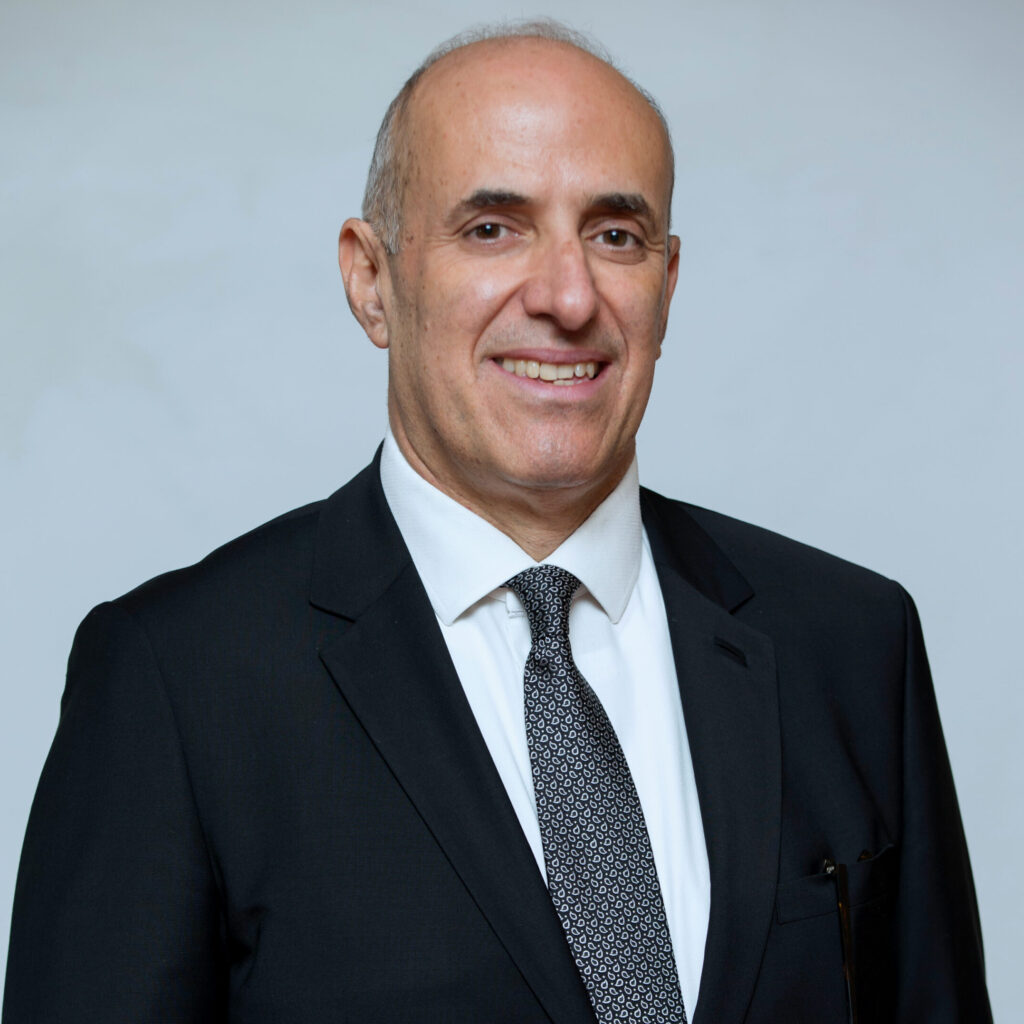Adipose tissue is a rich source of mesenchymal stem cells (also known as Medicinal Signaling Cells), Adipose Derived Stem Cells (ADSC)) located in the Stromal Vascular Fraction (SVF). Previously these cells were obtained enzymatically from lipoaspirates or expanded in cell cultures, leading to regulatory problems or the need for expensive GMP laboratories if cells needed to be cultured. Enzymatically processed lipoaspirate contains ADSCs, endothelial precursor cells (EPCs), endothelial cells (ECs), macrophages, smooth muscle cells, lymphocytes, pericytes, as well as pre-adipocytes, collectively named the SVF (1). SVF has been shown to be effective in the symptomatic treatment of OA. A recent meta-analysis of 79 RCTs with 8761 patients were comparing the intra-articular injection of autologous conditioned serum (ACS), bone marrow aspirate concentrate (BMAC), botulinum toxin, corticosteroids (CS), hyaluronic acid (HA), mesenchymal stem cells (MSC), ozone, saline placebo, platelet-rich plasma (PRP), plasma rich in growth factor (PRGF), and stromal vascular fraction (SVF) demonstrated that SVF injections resulted in the greatest improvement in pain and functional outcomes in patients with knee OA at up to 1 year (2).
Regulatory issues have led to the development of microfragmented adipose tissue techniques with minimal manipulation; here autologous cells are harvested, processed and used at the point of care without expansion/enzymatic treatment (3). Subcutaneous fat may be harvested from the abdomen or thigh using dedicated lipoaspiration cannulae and mechanically processed using filtration/fragmentation, centrifugation and lavage. The final product usually called Microfragmented Adipose Tissue (MFAT). This process results in the removal of blood elements and maintenance of tissue structure and stromal cell populations (4). MFAT contains varying amounts of stromal cells exhibiting the phenotype of ADSC’s (such as CD73, CD90 and CD105) as well as CD44 and CD146 found in pericytes. MFAT has similar regenerative, angiogenic, anti-fibrotic and immunomodulatory properties to its enzymatically digested counterpart (1, 5) and has recently been used for the symptomatic treatment of osteoarthritis (OA). Compared to BMAC, adipose tissue has a higher percentage of nucleated cells (0.001–0.01% vs 15-30%) and is less likely to be affected by the patient’s age (6). Cell viability has been reported be around 80% for various point of care mechanical processing techniques of lipoaspirate (7).
The mechanical processing method, cell number, viability and characterization of MFAT is not standardized, leading to difficulty in comparing the outcomes of different devices. A recent review by Liu et al., identified 13 unique devices/systems for the mechanical processing of adipose tissue and found that when cell concentration, cell viability and MSC immuno-phenotypic analysis was considered, the most effective manual devices/systems were ones using filtration and cutting/mincing (7). However no definite conclusions on clinical effectiveness could be reached due to heterogeneity of the data (7).
A systematic review of 12 clinical trials using different techniques of processing adipose tissue, has found improvement is pain and functional scores of patients with knee OA up to 2-years (8). Unfortunately, most of the studies were low-quality only two were prospective randomized controlled trials. Most studies on MFAT injections report improvements up to 2-years, with decreasing effectiveness over time. However, the expected duration of symptomatic improvement with MFAT treatment is not clear, some studies report deteriorating outcomes after one year (9).
Although generally indicated for mild to moderate OA, MFAT has also been used for advanced knee OA, with acceptable outcomes. An international multi-centric study of 75 patients found the best outcomes were in K-L 2 patients, although patients with K-L 4 arthritis and previous surgeries also benefited from MFAT injections (10). In another prospective series of 20 patients with K-L 4 OA, conversion to total knee arthroplasty was 15% at 12 months (11). Another 4-year follow-up study with MFAT injection demonstrated a 68% effectiveness regardless of cartilage status, although patients with synovitis had a 75% failure rate (12). These outcomes have led to the proposal of MFAT injections as a low-morbidity alternative biological treatment to delay the need for total knee replacement in suitable patients (13).
The addition of MFAT to microfracture has been shown to provide superior cartilage restoration compared microfracture alone in focal chondral defects in humans (14). However, no structural change cartilage morphology in follow-up MRI’s have been conclusively demonstrated in isolated intra-articular MFAT injections in patients with OA. A recent study with d-GEMRIC MRI at 2 years after MFAT injection in patients with knee OA has shown increased GAG content, but further studies are needed to prove the disease modifying effect of MFAT on OA (15).
 Microfragmented adipose tissue may also be used in combination with other treatments such as PRP and arthroscopic debridement. Duscher has coined the term Lipoarthroplasty for this combination treatment although long term outcomes are lacking (16). A randomized multicenter study of 302 patients found superior outcomes with combined MFAT+arthroscopy compared to HA+arthroscopy at 2-years (17). Similarly another prospective study of 78 patients found superior outcomes in patients with arthroscopic debridement + MFAT compared to debridement alone at 29 months (18).
Microfragmented adipose tissue may also be used in combination with other treatments such as PRP and arthroscopic debridement. Duscher has coined the term Lipoarthroplasty for this combination treatment although long term outcomes are lacking (16). A randomized multicenter study of 302 patients found superior outcomes with combined MFAT+arthroscopy compared to HA+arthroscopy at 2-years (17). Similarly another prospective study of 78 patients found superior outcomes in patients with arthroscopic debridement + MFAT compared to debridement alone at 29 months (18).
The superiority of MFAT procedures to other injectable orthobiologics has not been established. Three RCT’s comparing MFAT with PRP have found similar improvements in pain and function with both treatments in patients with mild to moderate OA. (19, 20, 21). Two studies comparing BMAC vs. MFAT have found similar improvements in patient reported outcomes and function at 6 months & 1 year respectively (22, 23). Although a protocol for RCT has been published (24), there are no studies comparing the efficacy of enzymatically digested vs mechanically fragmented adipose tissue.
In conclusion MFAT injection is a safe and effective symptomatic treatment alternative for mild to moderate knee OA. There are a variety of processing techniques resulting in different cell counts, viability and cell phenotypes, making comparison between techniques difficult. The quality of published studies has increased in recent years, and this will lead to a better understanding of efficacy and patient selection. Disease modifying effect of MFAT on OA has not been conclusively demonstrated. The superiority of MFAT treatment to other injectable orthobiologics has not been established and further studies are needed to define subtle differences in outcomes.
References
- Senesi L, De Francesco F, Farinelli L, Manzotti S, Gagliardi G, Papalia GF, Riccio M, Gigante A. Mechanical and Enzymatic Procedures to Isolate the Stromal Vascular Fraction From Adipose Tissue: Preliminary Results. Front Cell Dev Biol. 2019 Jun 7;7:88.
- Anil U, Markus DH, Hurley ET, Manjunath AK, Alaia MJ, Campbell KA, Jazrawi LM, Strauss EJ. The efficacy of intra-articular injections in the treatment of knee osteoarthritis: A network meta-analysis of randomized controlled trials. Knee. 2021 Oct;32:173-182.
- Akkawi I, Draghetti M, Zmerly H. Minimally manipulated adipose derived mesenchymal stromal cells and osteoarthritis: A narrative review. Acta Biomed. 2022 Mar 14;93(1):e2022135.
- Ragni E, Viganò M, Torretta E, Perucca Orfei C, Colombini A, Tremolada C, Gelfi C, de Girolamo L. Characterization of Microfragmented Adipose Tissue Architecture, Mesenchymal Stromal Cell Content and Release of Paracrine Mediators. J Clin Med. 2022 Apr 15;11(8):2231.
- Guo B, Sawkulycz X, Heidari N, Rogers R, Liu D, Slevin M. Characterisation of Novel Angiogenic and Potent Anti-Inflammatory Effects of Micro-Fragmented Adipose Tissue. Int J Mol Sci. 2021 Mar 23;22(6):3271.
- Rogers CJ, Harman R, Sheinkop MB, Hanson P, Ambach MA, David T, Desai R, Sampson S, Aufierro D, Bowen J, Malanga G. Clinical Evaluation of Safety and Efficacy of a Central Current Good Manufacturing Practices Laboratory Produced Autologous Adipose-Derived Stromal Vascular Fraction Cell Therapy Product for the Treatment of Knee Osteoarthritis. Stem Cells Dev. 2024 Apr;33(7-8):168-176.
- Liu P, Gurung B, Afzal I, Santin M, Sochart DH, Field RE, Kader DF, Asopa V. The composition of cell-based therapies obtained from point-of-care devices/systems which mechanically dissociate lipoaspirate: a scoping review of the literature. J Exp Orthop. 2022 Oct 9;9(1):103.
- Lavagnolo U, Veronese S, Negri S, Magnan B, Sbarbati A. Lipoaspirate processing for the treatment of knee osteoarthritis: a review of clinical evidences. Biomed Pharmacother. 2021 Oct;142:111997.
- Yu Y, Lu Q, Li S, Liu M, Sun H, Li L, Han K, Liu P. Intra-Articular Injection of Autologous Micro-Fragmented Adipose Tissue for the Treatment of Knee Osteoarthritis: A Prospective Interventional Study. J Pers Med. 2023 Mar 10;13(3):504.
- Gobbi A, Dallo I, Rogers C, Striano RD, Mautner K, Bowers R, Rozak M, Bilbool N, Murrell WD. Two-year clinical outcomes of autologous microfragmented adipose tissue in elderly patients with knee osteoarthritis: a multi-centric, international study. Int Orthop. 2021 May;45(5):1179-1188.
- Hudetz D, Borić I, Rod E, Jeleč Ž, Kunovac B, Polašek O, Vrdoljak T, Plečko M, Skelin A, Polančec D, Zenić L, Primorac D. Early results of intra-articular micro-fragmented lipoaspirate treatment in patients with late stages knee osteoarthritis: a prospective study. Croat Med J. 2019 Jun 13;60(3):227-236. doi: 10.3325/cmj.2019.60.227. PMID: 31187950; PMCID: PMC6563172.
- Onorato F, Rucci M, Alessio-Mazzola M, Bistolfi A, Castagnoli C, Formica M, Ferracini R. Autologous microfragmented adipose tissue treatment of knee osteoarthritis demonstrates effectiveness in 68% of patients at 4-year follow-up. Arch Orthop Trauma Surg. 2024 Jan 11.
- Heidari N, Borg TM, Olgiati S, Slevin M, Danovi A, Fish B, Wilson A, Noorani A. Microfragmented Adipose Tissue Injection (MFAT) May Be a Solution to the Rationing of Total Knee Replacement: A Prospective, Gender-Bias Mitigated, Reproducible Analysis at Two Years. Stem Cells Int. 2021 Jun 9;2021:9921015.
- Bisicchia S, Bernardi G, Pagnotta SM, Tudisco C. Micro-fragmented stromal-vascular fraction plus microfractures provides better clinical results than microfractures alone in symptomatic focal chondral lesions of the knee. Knee Surg Sports Traumatol Arthrosc. 2020 Jun;28(6):1876-1884.
- Borić I, Hudetz D, Rod E, Jeleč Ž, Vrdoljak T, Skelin A, Polašek O, Plečko M, Trbojević-Akmačić I, Lauc G, Primorac D. A 24-Month Follow-Up Study of the Effect of Intra-Articular Injection of Autologous Microfragmented Fat Tissue on Proteoglycan Synthesis in Patients with Knee Osteoarthritis. Genes (Basel). 2019 Dec 17;10(12):1051.
- Weninger P, Feichtinger X, Steffel C, Kerschbaumer C, Duscher D. Arthroscopy with Lipoaspirate and Plasma Infiltration Using Adipose-Derived Stem Cells Plus Platelet-Rich Plasma: Harvesting and Injection for Arthroscopic Treatment of Cartilage Defects of the Knee. Arthrosc Tech. 2023 Nov 20;12(12):e2265-e2271.
- Wu CZ, Shi ZY, Wu Z, Lin WJ, Chen WB, Jia XW, Xiang SC, Xu HH, Ge QW, Zou KA, Wang X, Chen JL, Wang PE, Yuan WH, Jin HT, Tong PJ. Mid-term outcomes of microfragmented adipose tissue plus arthroscopic surgery for knee osteoarthritis: A randomized, active-control, multicenter clinical trial. World J Stem Cells. 2023 Dec 26;15(12):1063-1076.
- Ulivi M, Meroni V, Viganò M, Colombini A, Lombardo MDM, Rossi N, Orlandini L, Messina C, Sconfienza LM, Peretti GM, Mangiavini L, de Girolamo L. Micro-fragmented adipose tissue (mFAT) associated with arthroscopic debridement provides functional improvement in knee osteoarthritis: a randomized controlled trial. Knee Surg Sports Traumatol Arthrosc. 2023 Aug;31(8):3079-3090.
- Kaszyński J, Bąkowski P, Kiedrowski B, Stołowski Ł, Wasilewska-Burczyk A, Grzywacz K, Piontek T. Intra-Articular Injections of Autologous Adipose Tissue or Platelet-Rich Plasma Comparably Improve Clinical and Functional Outcomes in Patients with Knee Osteoarthritis. Biomedicines. 2022 Mar 16;10(3):684.
- Baria M, Barker T, Durgam S, Pedroza A, Flanigan D, Jia L, Kaeding C, Magnussen R. Microfragmented Adipose Tissue Is Equivalent to Platelet-Rich Plasma for Knee Osteoarthritis at 12 Months Posttreatment: A Randomized Controlled Trial. Orthop J Sports Med. 2024 Mar 18;12(3):23259671241233916.
- Zaffagnini S, Andriolo L, Boffa A, Poggi A, Cenacchi A, Busacca M, Kon E, Filardo G, Di Martino A. Microfragmented Adipose Tissue Versus Platelet-Rich Plasma for the Treatment of Knee Osteoarthritis: A Prospective Randomized Controlled Trial at 2-Year Follow-up. Am J Sports Med. 2022 Sep;50(11):2881-2892.
- Pintore A, Notarfrancesco D, Zara A, Oliviero A, Migliorini F, Oliva F, Maffulli N. Intra-articular injection of bone marrow aspirate concentrate (BMAC) or adipose-derived stem cells (ADSCs) for knee osteoarthritis: a prospective comparative clinical trial. J Orthop Surg Res. 2023 May 11;18(1):350.
- Mautner K, Bowers R, Easley K, Fausel Z, Robinson R. Functional Outcomes Following Microfragmented Adipose Tissue Versus Bone Marrow Aspirate Concentrate Injections for Symptomatic Knee Osteoarthritis. Stem Cells Transl Med. 2019 Nov;8(11):1149-1156.
- Krześniak AM, Radzimowski K, Stolarczyk A. Comparison of the treatment results of knee osteoarthritis using adipose tissue mesenchymal stromal cells derived through enzymatic digestion and mechanically fragmented adipose tissue. Medicine (Baltimore). 2021 Mar 5;100(9):e24777.



